Features
Technology Transfer Successes
A hallmark of SRP's success is effective technology transfer. Research findings have led to novel therapeutic drug products, environmental sampling devices, and remediation approaches. The examples below illustrate an array of businesses and products that have spun out of SRP funding.
From Bench to Bedside
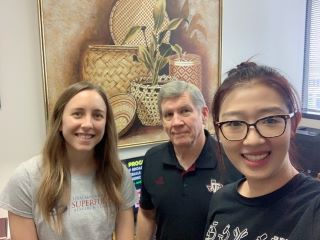
Building on more than 30 years of research, members of the Texas A&M University (TAMU) SRP Center have developed therapeutic materials that can bind to hazardous chemicals in the digestive tract and reduce their absorption. Added to food or water, these materials, called enterosorbents, can help minimize chemical exposures following natural disasters, chemical spills, and other emergencies.
Led by Timothy Phillips, Ph.D., the work has spawned two small businesses: Texas EnteroSorbents, Inc., and Salient Pharmaceuticals.
Phillips and post-doctoral research associate Meichen Wang, Ph.D., have has also earned two patents for enterosorbent technologies.
The researchers continue to fine-tune their technology. In 2021, Phillips and team showed that edible clays amended with nutrients have potential for reducing uptake of per- and polyfluorinated alkyl substances (PFAS) from contaminated drinking water and food. In a related study published in 2022, the researchers demonstrated that nutrient-amended clays could be included in soil to decrease PFAS uptake into plants .
The lab is also investigating the use of clays in topical formulas to reduce skin exposure to chemicals in water during disasters.
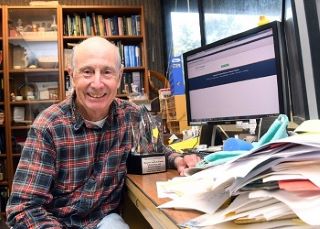
SRP research is informing therapies for treating pain in animals and humans, too. Researchers led by Bruce Hammock, Ph.D., of the University of California (UC), Davis SRP Center are renowned for their discovery of soluble epoxide hydrolase (sEH), an enzyme in the body that breaks down fatty acids. Among various roles, fatty acids are involved in the body's inflammatory response.
The team has shown that blocking sEH can potentially treat a variety of health problems, such as high blood pressure , chronic pain, and neurological diseases like Parkinson's and Alzheimer's .
With nearly 30 patents , Hammock's team has taken their research to market. Through EicOsis LLC , a small business funded in part by NIEHS, they are developing commercial sEH inhibitors to treat pain in humans and animals as alternatives to opioids. In November 2020, EicOsis announced the successful completion of a Phase 1a clinical trial for a sEH inhibitor drug for neuropathic pain management. Caused by damage or injury to the nervous system, neuropathic pain is often described as a shooting or burning pain.
Hammock and colleagues are also examining sEH as a target for treating asthma. In 2022, a preliminary study showed that an sEH-inhibiting compound stopped inflammation, suppressed airway narrowing, and prevented mucus buildup in asthmatic mice.
Wearing Wristbands to Track Exposures
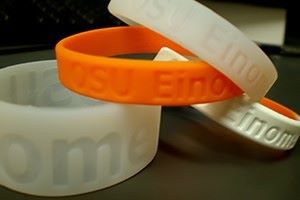
Researchers at the Oregon State University (OSU) SRP Center developed an approach to monitor personal chemical exposures using silicone wristbands. Because silicone mimics the way that skin and other body tissues absorb chemicals, the wristbands substitute for direct tissue sampling. After wearing the wristbands for a period of time, ranging from a day to a month, users return them to the researchers for chemical analysis.
The team, led by Kim Anderson, Ph.D., developed and hold a patent on the methods to extract and analyze over 1,500 chemicals from silicone, including pesticides, personal care products, smoke and oil compounds, and flame retardants.
Anderson and Steven O'Connell, Ph.D., a former OSU SRP trainee, also helped co-found MyExposome, Inc., a small business dedicated to developing technologies for monitoring individual environmental exposures.
The wristbands have been deployed to track and compare exposures across continents and populations. In a study of wristbands worn by 262 participants in North America, South America, and Africa, no two wristbands had the same chemical profile, even among those from the same community.
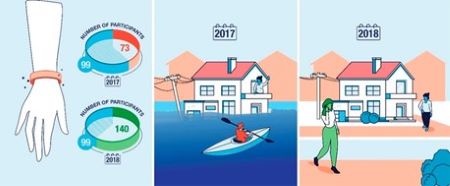
OSU SRP researchers worked with Tribal partners to initiate a community-engaged study using wristbands to measure exposures to polycyclic aromatic hydrocarbons (PAHs), contaminants produced from burning coal, oil, or wood, as well as during some Tribal cultural and spiritual practices like burning candles and incense. Community members reported feeling more aware about their potential exposure to PAHs from different sources and, in many cases, felt empowered to take steps to reduce their exposure.
Recently, researchers have used silicone wristbands to monitor exposures after climate disasters. An OSU study showed that chemical exposure levels were generally higher post-Hurricane Harvey. According to the OSU team, engaging communities and incorporating local knowledge into research frameworks can help promote community resilience after disasters, such as oil spills, hurricanes, and wildfires.
Portable Mercury Monitoring

Researchers at Picoyune, an SRP-funded small business, develop portable, low-cost mercury detectors to monitor personal exposures in real time. Gold miners, chemical manufacturers, and other industrial workers at increased risk of mercury exposure can attach the small devices to their clothing, eliminating the need for heavy lab equipment to test for mercury on the job.
Jay James, Ph.D., a former trainee at the UC Berkeley SRP Center, co-founded the company in 2013. The idea for Picoyune stemmed from UC Berkeley's SRP research to develop small-scale sensors to detect toxic heavy metals at Superfund sites.
At the 2020 NIEHS Virtual Technology Fair, James presented on how this device, compared to traditional mercury monitoring techniques, costs less to assemble, is smaller, and can measure mercury without interference from other chemicals. It is the first mercury monitor that is wearable, immediate, and accurate in complex environments.
In the aftermath of Hurricane Florence in 2018, researchers from the Duke University SRP Center and TAMU SRP Center deployed Picoyune's sensors to test for mercury in soil and water. Floodwater may carry contaminants and increase the risk of chemical exposure in communities, illustrating need for portable technologies that quickly measure pollutant levels.
Picoyune won a gold-level award in the Artisanal Mining Grand Challenge for applying their mercury monitor to small-scale gold mining. According to James, mercury remains a major pollutant and threat to gold miners' health, and Picoyune's low-cost device may allow them to reach more stakeholders in the global effort to reduce mercury exposures.
Cleaning Up Contaminants

Angela Gutierrez, Ph.D., a post-doctoral researcher at the University of Kentucky (UK) SRP Center, explores low-cost, sustainable water treatment strategies. A former K.C. Donnelly Externship Award recipient and Karen Wetterhahn Memorial Award winner, Gutierrez is also the principal investigator at Bluegrass Advanced Materials, LLC, a commercial spinoff from the UK SRP Center.
With initial support from an SRP small business grant, Bluegrass is developing technology to remove persistent organic contaminants, such as PFAS and polychlorinated biphenyls (PCBs), from water. The technology entails a chemical called a flocculant that, added to water, causes contaminant particles to aggregate in clumps called flocs, which can subsequently be removed.
The process of flocculation is widely used to separate and remove suspended solids from drinking water and wastewater. However, traditional flocculants are inefficient and have rarely been used on dissolved contaminants like PFAS. Gutierrez, co-PI James Zach Hilt, and team have created a "smart" flocculant that can produce flocs within minutes rather than hours. The technology also produces denser flocs with less energy input than other smart flocculants.
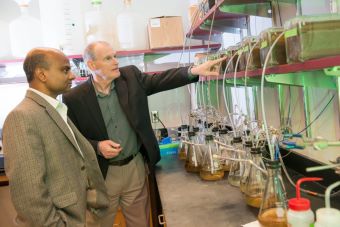
Researchers funded by SRP have also developed a technology for treating contaminated water in aquatic ecosystems. SediMite, developed by Upal Ghosh, Ph.D., of the University of Maryland, Baltimore County, and collaborators, uses activated carbon in the form of specialized pellets to bind to PCBs and reduce their bioavailability, or uptake by organisms - in this case, fish and other aquatic organisms.
SediMite is the result of years of sustained research by Ghosh and colleagues. Following an early project, funded in part by SRP, initial pilot-scale tests demonstrated that SediMite was a feasible technology for use in the field. Ghosh and team patented the product in 2010.
In 2013, the technology was implemented at full scale to remediate a 5-acre lake in Dover, Delaware. It was also selected as a component of the cleanup strategy for a contaminated sediment site in Middle River, Maryland. SediMite is now being used to remediate Paradise Creek, a 14-acre tributary to the Elizabeth River in Virginia that is contaminated with PCBs.
Ghosh and Kevin Sowers, Ph.D., also of the University of Maryland, in collaboration with Amar Wadhawan, Ph.D., from Arcadis, an engineering and design company, are also developing carbon-based sorbent materials to enhance the ability of bacteria to break down mixtures of PCBs and other chlorinated organic contaminants in groundwater and sediment.
Other Successes
Other examples of effective technology transfer include:
-
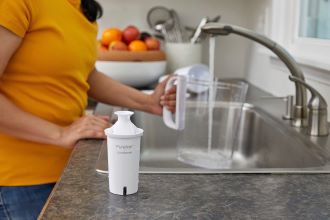
Cyclopure’s filter is designed to bind and remove all 40 PFAS compounds targeted by the U.S. Environmental Protection Agency’s PFAS Roadmap. (Photo courtesy of Cyclopure) Cyclopure , an SRP-funded small business, developed a new filter cartridge compatible with Brita pitchers that can remove PFAS from drinking water.
- SRP small business grantee OndaVia deployed their water testing system at the NIH campus in Bethesda, Maryland. The system is fully automated and designed to measure cyclohexylamine, a chemical used to control corrosion in pipes that is toxic to humans.
- Microbial Insights, an SRP-funded small business, is commercializing tools to monitor the breakdown of environmental contaminants. The company stemmed from Frank Loeffler's individual research grant work to understand how bacteria can be used to break down chemicals at hazardous waste sites.
- As part of an SRP small business project, researchers at EnChem Engineering, Inc. are developing a technology to expedite removal of PFAS from soil and groundwater. After flushing the soil and groundwater with a non-toxic agent that binds to PFAS, they can extract and destroy the PFAS, and then return the clean soil and groundwater to the site.
- Researchers at the University of Washington SRP Center and SRP-funded Edenspace Systems Corporation developed approaches to remove chlorinated organic solvents from the environment using poplar trees. They developed genetically enhanced poplar trees that showed promise for taking up and removing the toxic chemicals from soil.
-
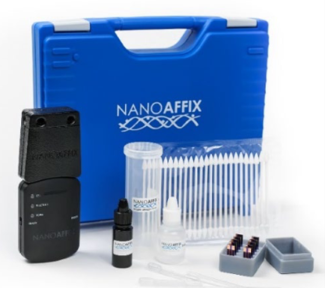
NanoAffix made their test kits available for sale in 2022. (Photo courtesy of NanoAffix) Roger Giese, Ph.D., of the Northeastern University SRP Center , received funding from the National Institute of Food and Agriculture to develop a single test for many cancer-causing chemicals in food to replace the need for many, expensive tests.
- SRP-funded small business NanoAffix Science, LLC developed a portable lead test kit that can rapidly detect and quantify lead in water. This lead test kit enables people to obtain results onsite in minutes instead of collecting a sample, shipping to a lab, and waiting several days for results.
to Top



